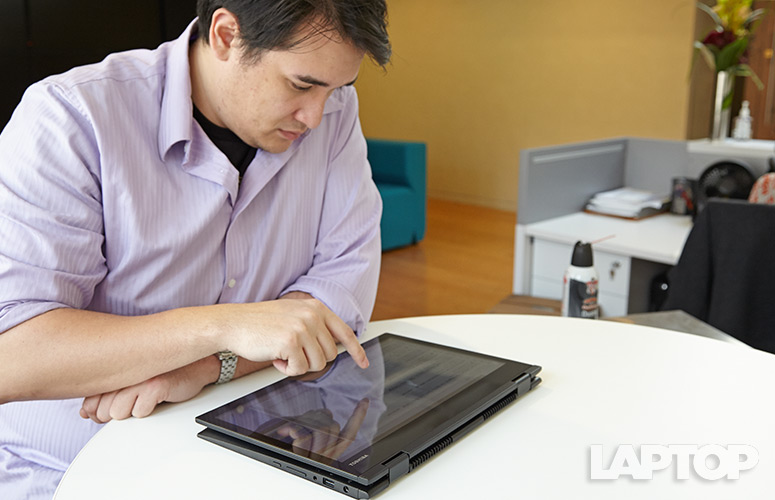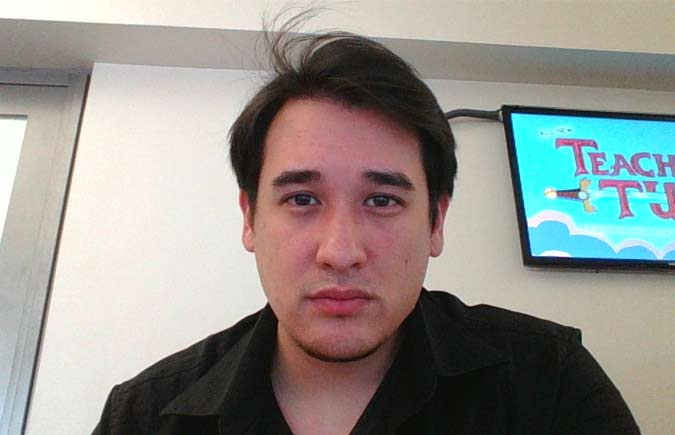Laptop Mag Verdict
The Radius 14 is provides fairly strong performance and a rotating touch screen on the cheap, but the design isn't comfortable.
Pros
- +
Strong performance for price
- +
Dedicated Cortana button
- +
Above-average battery life
Cons
- -
Front lip feels sharp
- -
Undersized keys
Why you can trust Laptop Mag
The nice thing about the rise of 2-in-1s is that as they continue to grow in popularity, they're getting more affordable. The Toshiba Satellite Radius 14 offers a rotating 14-inch touch screen and solid Intel Core-i3 performance for just $500 (exclusively from Best Buy). The Radius 14 also has a battery that lasts longer than most hybrids in its price range, and Toshiba added a handy dedicated Cortana button so you can talk to Windows 10's assistant with ease. But some ergonomic issues prevent this convertible from being a killer deal.
Design
At first glance, the Radius 14 doesn't do much to distinguish itself, sporting a matte black plastic chassis with a subtle brushed texture on top and bottom. But once you open up the lid, you're treated to a big 14-inch screen that rotates all the way around into tablet mode and a premium-feeling metal deck with the same brushed finish.
The problem is the plastic rim around the edge of the system, which rubs against your wrist when it's resting on the deck. Those with smaller hands may not notice, but around our office, the majority of people took issue with the Radius 14's thick lower lip almost immediately. It also doesn't help that the pointy edges feel a little sharp.
The hinge on the Radius 14 isn't the strongest I've seen on a 2-in-1, but it prevented the screen from flopping around wildly in all of its various positions.
At 12.8 x 9.1 x 0.86 inches and weighing 4.5 pounds, the Radius 14 finds a good middle ground between 13-inch 2-in-1s, such as the Asus Transformer Book Flip TP300 (12.8 x 9.1 x 0.86 inches and 3.8 pounds) and larger convertibles, such as Dell's Inspiron 15 7000 (15 x 9.9 x 0.78 inches and 4.6 pounds).
Keyboard and Touchpad
Sign up to receive The Snapshot, a free special dispatch from Laptop Mag, in your inbox.
With an actuation weight of 55 grams and a key travel of 1.2mm, the Radius 14's keyboard feels lighter and shallower than most keyboards, but that's not its biggest issue. The Radius 14's keys measure just 10 mm from front to back, which is 2 millimeters shorter than the typical 12mm size. And while I was able to hit my typical average of 78 words per minute on 10fastfingers.com's test, I never really felt comfortable. After another 30 minutes of typing, I started to notice a slight pain in my wrist (especially the right), a not-so-pleasant reminder of Radius 14's poorly designed front lip.
The one consolation is Toshiba's addition of a dedicated Cortana key, something not found on laptops from other makers. This gives you super-fast access to Microsoft's digital assistant and helps save the battery by eliminating the need to turn on Cortana's constant listening mode.
The 4 x 2.6-inch touchpad has a smooth matte surface that's a pleasure to touch, and it responded accurately to both general mouse movements and gestures such as two-finger scrolling.
Display
The Radius 14 has a 14-inch, 1366 x 768 display, which looks lackluster due to weak color range and mediocre brightness. When I watched the trailer for Disney's The Jungle Book, I missed the golden color of the tall savannah grass I saw on other display screens. The Radius 14 also suffers from poor viewing angles, which causes colors to shift significantly if you move outside of the display's sweet spot.
The Radius 14's panel registered an average brightness of 182 nits, which put it ahead of the Asus TP300 (161), but behind the Lenovo Edge 15 (199), the HP x360 13t (260) and the thin-and-light average of 231 nits.
The Toshiba's 14-inch screen recreated just 64.2 percent of the sRGB spectrum, which was slightly better than the Edge 15 (58), about the same as the HP x360 13t (64) but less than the Asus TP 300 (68.6). The thin-and-light average is considerably higher at 80.7 percent.
As for color accuracy, the Radius 14 earned a Delta-E rating of 3.69 (closer to zero is better), which was worse than the HP x360 13t (0.8) but better than the Asus TP300 (8.7).
Audio
Behind the keyboard sits a metal grille that covers the Radius 14's Harmon Kardon speakers. When I listened to Brave Shores' "Never Come Down", the Toshiba did a good job putting out a lot of sound and recreating the sugary sweet vocals and guitar, but the system had a difficult time recreating the punch of the crunchy bass line. Even after applying the bass boost and adjusting the equalizer using the Radius 14's DTS Sound software, it didn't pump up the bottom end.
Heat
The Radius 14 did an acceptable job staying under our 95-degree comfort threshold during the Laptop Mag Heat Test (streaming 1080p video from Hulu for 15 minutes). The bottom measured the hottest at 90 degrees, while the touchpad and the space between the G and H keys stayed cooler at 77 and 80.5 degrees, respectively.
Ports and Webcam
For connectivity, the Radius 14 features three USB ports: one 3.0 port with USB Sleep and Charge (so you can charge your phone or tablet even when the laptop is off), one vanilla 3.0 port and a single USB 2.0 port (it's the one on the left). You also get a combo headphone/mic jack, an HDMI port for hooking up to an external display and an SD card reader.
An HD webcam takes surprisingly decent photos, and dual TruTalk mics provide good, but not great, audio. In a picture at our well-lit office, the Radius 14 captured good details in my hair and face, although overall clarity was marred by a lot of noise.
Performance
Equipped with a 2.1-GHz Intel Core i3 5015U CPU, 6GB of RAM and a 500GB hard drive, the Radius 14 has more than enough to power to handle everyday computing needs, such as surfing the Web or watching high-def movies. Even with 20 tabs open in Chrome or Microsoft's new Edge browser, there wasn't any noticeable lag or slowdown.
With a score of 4,671 in Geekbench 3, the Radius 14 is faster than other Core-i3 convertibles, such as the 13-inch Asus Transformer Book Flip TP300 (3,922) and the HP Pavilion x360 13t (4,490). However, Lenovo's larger 15-inch Edge 15 scored a higher 4,722, thanks to its beefier Intel Core i5 processor.
When we used the Radius 14 to match 20,000 names and addresses in OpenOffice, it completed the task in 6 minutes and 31 seconds. That's faster than the Asus TP300's 7:15, about the same as the X360 13t's 6:28, and expectedly slower than the i5-powered Lenovo Edge 15's 5:07.
The Radius 14's 500GB 5400 rpm hard drive offered a transfer rate of 29.9 MBps, a bit faster than similarly priced machines. The Asus TP300 was the closest at 28 MBps, while the HP Pavilion x360 13t and the Lenovo Edge 15 were further behind at 25.8 and 23.10 MBps, respectively.
Graphics
Featuring integrated Intel HD Graphics, the Radius 14 struggled with anything more than the most casual games or graphics software. In World of Warcraft, the Radius 14 managed just 20 frames per second at 1366 x 768 and at auto settings. That was the lowest framerate when compared with the Asus TP 300 (24 fps), the HP X360 13t (38 fps) and the Lenovo Edge 15 (43 fps) at the same settings.
Battery Life
On the Laptop Mag Battery Test, which consists of continuous Web surfing over Wi-Fi with the screen at 100 nits of brightness, the Radius 14 lasted 6 hours and 22 minutes. While that's short of the HP Pavilion x360 13t (6:56), it's longer than the paltry 5:13 of the Lenovo Edge 15 and the Asus TP300's 6:12.
MORE: The Best Laptops for Every Need
Configurations
The suggested retail price of our review unit is $585, but on Best Buy you can get it for just $500. On Toshiba's site, you can also choose a faster and more expensive model for $700, which features an Intel Core i5 CPU, 6GB of RAM and a 1TB HDD.
Software and Warranty
The Radius 14 comes pre-installed with Windows 10, which means you get handy features such as Microsoft's digital assistant Cortana, the new Edge Web browser and automatic switching from desktop to tablets modes whenever you flip back the display.
Toshiba also includes a standard one-year warranty and an assortment of software utilities, such as the PC Health Monitor, for monitoring the condition of your battery and stats, such as CPU temp and fan speed. Toshiba Service Station helps fix security vulnerabilities and makes sure your drivers are up-to-date.
Bottom Line
At a manufacturer's suggested price of $585, the Satellite Radius 14 has a hard time competing with its less expensive 2-in-1 competition. But at $500 from Best Buy, things get a lot more interesting. At that price you're getting a lot of laptop for the money, including a big 14-inch screen, decent battery life and good CPU performance.
The drawback is that the Radius 14's plastic lip bites your hand when want you type. Add in keys that are almost 20 percent smaller than normal, a display that could use a little more color and brightness, and you're left with a hybrid that's a real mix of highs and lows. With just a little more polish, the Radius 14 could be a real gem.
Toshiba Satellite Radius 14 E45W-C (2015) Specs
| Bluetooth | Bluetooth 4.1 |
| Brand | Toshiba |
| CPU | 2.1-GHz Intel Core i3 5015U |
| Card Slots | SD memory reader |
| Company Website | www.toshiba.com |
| Display Size | 14 |
| Graphics Card | Mobile Intel HD graphics |
| Hard Drive Size | 500GB |
| Hard Drive Speed | 5,400rpm |
| Hard Drive Type | Serial ATA |
| Native Resolution | 1366x768 |
| Operating System | Windows 10 |
| Optical Drive | None |
| Ports (excluding USB) | HDMI, Headphone/Mic, USB 3.0, USB 2.0 |
| RAM | 6GB |
| Size | 13.3 x 9.3 x 0.83-inches |
| Touchpad Size | 4 x 2.62-inches |
| USB Ports | 3 |
| Video Memory | Shared |
| Warranty/Support | one-year standard limited warranty |
| Weight | 4.5 pounds |
| Wi-Fi | 802.11ac |
| Wi-Fi Model | Intel Dual-Band Wireless-AC 31609 |
Sam Rutherford is a writer at Laptop Mag, focusing on laptop reviews and all the gadgets that make using a notebook just that much easier (or more fun). Over the years, he reviewed some iconic laptops, including gaming beasts from Alienware, Asus, Acer, Gigabyte, and HP. Outside of gaming laptops, Sam has also reviewed notebooks oriented around productivity, such as the Lenovo IdeaPad or the Dell XPS.







